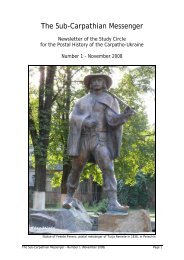The Sub-Carpathian Messenger - Jay T. Carrigan
The Sub-Carpathian Messenger - Jay T. Carrigan
The Sub-Carpathian Messenger - Jay T. Carrigan
You also want an ePaper? Increase the reach of your titles
YUMPU automatically turns print PDFs into web optimized ePapers that Google loves.
Tønnes OrePostcards sent as printed matterIn the last issue of TSCM Helmut Kobelbauer presented a challenge: Why could so many postcardsbe sent at a reduced rate during the Visszatért period? In my opinion the answer is fairly obvious,and has nothing to do with Visszatért or Carpatho-Ukraine in particular.It is well known that a large number of countries have had the practice of allowing a postcardwith a message of five words or less to be mailed as printed matter. This is in fact in accordancewith a UPU rule which was established as early as 1899, in which the following was explicitlyallowed on a sending defined as printed matter: 'To add in manuscript, on printed visiting cards,the address of the sender, his title, as well as good wishes, congratulations, thanks, condolencesor other formulas of courtesy, expressed in five words at most'. A printed matter should bemarked as such by writing printed matter on the front, and up to 1920 postcards can be seenwhere the printed word 'postcard' has been crossed out and replaced by 'printed matter'.From some point of time, the explicit 'printed matter' specification for postcards with less thanfive words was apparently considered unnecessary. It was probably at the same time that UPUdropped the requirement that the word 'postcard' should be present on postcards.It also appears that it was optional for the UPU countries to adopt the rule that defines a postcardwith a short message as printed matter. <strong>The</strong> rule does not seem to have been adopted by Austriaor Hungary in the times of the monarchy. (On the other hand, Italy did practice the rule – therewere even three Italian postcard rates: One for postcard with signature only, one for postcardwith five words or less, and one for postcards with more than five words.)But it is obvious that in the period of special interest to us – after 1938 – Hungary had adopted therule. <strong>The</strong> rule must have been well known, as one can see from the examples given by Helmut inTSCM 11. <strong>The</strong> illustrations on the following pages show how the rule was practiced, and it is interestingto observe that the postal employees really took the time to count the words on the postcards,and marked postage due if there were too many. It seems that the date was acceptable inaddition to the five words.<strong>The</strong> printed matter rate was raised from 2 to 3 f. from 15 September, 1941, and the postcard ratewas raised from 10 to 12 f. from the same date. But it should be observed that the next raise ofthe printed matter rate – from 3 to 4 f. – was in force from 1 March, 1943, whereas the postcardrate was raised from 12 to 18 f. from 1 July, 1943.We can conclude that any speculation of a special visszatért rate is pure fantasy.But one case of special handling of mail from the visszatért areas can be observed:In the first weeks Hungarian stamps were not yet available in all post offices, and for this reasonunfranked mail was accepted with no extra penalty. <strong>The</strong> receiver had to pay postage due, butonly by the same amount as the ordinary postage – not the double amount as specified by thegeneral rule.This is illustrated by the two postcards on the next page. On the second one the sender has evenwritten 'Felvidékrıl – portómentes' (from the northern area – free of postage) which was a bit toooptimistic. <strong>The</strong>re was obviously no freedom from postage, but the postage due was only 10 f.<strong>The</strong> <strong>Sub</strong>-<strong>Carpathian</strong> <strong>Messenger</strong> – Number 12 (September 2010) Page: 20













